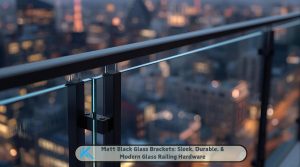Railing brackets are a small, but an essential element of any staircase. They guarantee comfort and safety by holding the handrail in place. They also serve a practical purpose by enhancing the overall design, giving staircases a polished and finished appearance.
In residential and commercial spaces railing brackets play an important role. From modern apartments to corporate offices and luxury interiors they support everyday use as well as aesthetics.
To help you choose the best railing bracket for your project this guide covers all the essential topics including, styles, materials, installation, maintenance, and purchasing advice.
What Are Railing Brackets for Stairs?
Railing brackets are fittings made to attach stair handrails to walls or posts. They are the main support system that keeps handrails stable during everyday use.
They are important for safety compliance, preventing accidents, and ensuring long-term stability. A handrail may loosen without the proper brackets, putting users in danger.
Additionally, railing brackets can be used as decorative elements. From plain utility styles to detailed designs they enhance the look of staircases while doing their job.
Styles of Stair Railing Brackets
Railing brackets come in a variety of styles each intended to meet particular requirements.
- Wall-Mounted Brackets
Wall-mounted brackets are the most common and practical options. They secure the rail firmly and fasten straight to the wall. Their simple design makes them suitable for both homes and offices.
- Adjustable Brackets
Custom designs or angled staircases benefit from adjustable brackets. They are perfect for projects with unusual layouts as they allow positioning flexibility.
- Heavy-Duty Brackets
These are designed to be strong and long-lasting. High-traffic areas, such as public buildings or outdoor staircases, are ideal for them. The strong construction of heavy-duty brackets ensures that the railing will remain stable over time.
- Decorative Brackets
Decorative brackets combine support with design. They add charm while fulfilling their function and come in a variety of styles, from sleek modern shapes to traditional scrolls.
- Glass Railing Brackets
Glass railing brackets hold up glass handrails in high-end interiors. They provide a sleek and modern appearance and are frequently found in hotels, shopping centers and upscale apartments.
Materials Used for Stair Railing Brackets
Choosing the correct material influences both durability and design.
- Stainless Steel
Stainless steel is corrosion-resistant, long-lasting, and easy to maintain.Its sleek finish complements both outdoor and contemporary interior design.
- Brass
Brass brackets have an elegant finish that adds a touch of class. They work well in premium interiors and give a warm, rich look.
- Aluminum
Lightweight and cost-effective, aluminum brackets are practical for budget projects. They are durable enough for homes and light-use spaces.
In short stainless steel offers strength, brass adds beauty, and aluminum balances cost with function.
How to Choose the Right Brackets
The type of staircase and its intended use determine which brackets to use.
Complement the staircase design with the bracket style. Decorative brackets enhance classic spaces while minimalist brackets look best in modern settings.
Consider location while choosing materials. Brass works well for luxurious indoor applications while stainless steel is best for outdoor use.
Consider strength. Places of business need heavy-duty support while homes might need light to medium strength.
Cost and safety should be balanced. Taking short cuts on quality can have long-term consequences.
Installation Guide (Simplified)
Installing railing brackets is straightforward with the right tools and care.
Tools needed: drill, screws, measuring tape, and a spirit level.
Steps:
- Mark the correct height and bracket positions along the wall.
- Fix each bracket securely with screws, keeping proper spacing between them.
- Attach the handrail, making sure it aligns well.
- Before using the railing check its firmness for final use.
Tip: While DIY is possible, professional installation is recommended for safety and finish.
Maintenance & Care Tips
Proper care guarantees railing brackets last longer and stay safe to use. Every material has different needs:
- Stainless Steel:
Stainless steel brackets are resistant to rust and stains but they still benefit from regular cleaning. Wiping them with a damp cloth removes dust and smudges. Outdoor installations can be preserved with the periodic wash with mild soap.
- Brass:
Brass brackets are known for their rich golden look, but they can tarnish over time. To keep them bright, polish them regularly with a brass cleaner or natural solutions like lemon and baking soda. They need a bit more maintenance than steel or aluminum, but reward you with a timeless finish.
- Aluminum:
Aluminum brackets are incredibly low maintenance. They are naturally strong and do not rust. Once in a while a quick wipe-down is sufficient. Long-term wear can be avoided for outdoor use by looking for surface scratches.
General Tip:
No matter the material, inspect brackets periodically to ensure screws remain tight. Check for damage or looseness especially in stairwells that are used regularly. Accidents can be avoided and expensive replacements can be avoided with early intervention.
Modern Design Trends in Railing Brackets
- Hidden Brackets
Hidden brackets are designed to stay out of sight, giving the impression that the handrail is floating. This design is popular in modern and minimal spaces that value clean lines. It offers the same strength as visible brackets but without detracting the aesthetics of the staircase.
- Matte Black and Brushed Steel Finishes
Finishes play a big role in current design choices. Matte black brackets are trending in industrial and contemporary interiors offering a bold contrast against lighter walls. Brushed steel brackets on the other hand bring a sleek and modern feel while being easy to pair with most rail designs.
- Glass-Compatible Brackets
Glass-compatible brackets are used to hold glass railings common in luxury homes, offices, and malls. They provide strong support while keeping the transparent and open look of glass panels intact. The result is a staircase that feels light, airy, and premium.
- Custom and CNC-Cut Brackets
With CNC (computer-controlled cutting) technology, railing brackets can be shaped into unique patterns or logos. This option is popular among designers and homeowners who want personalized interiors. Custom brackets can match the theme of a space, offering both individuality and function.
Buying Guide for Customers
When purchasing railing brackets, keep the following in mind:
- Match the bracket type to the project—residential, commercial, or luxury.
- Check the quality of the material, load capacity, and finish before buying.
- Source from trusted suppliers to ensure consistent quality and reliable support.
- For contractors and builders, buying in bulk can be cost-effective.
Common Mistakes to Avoid
- Selecting only by looks: Weak brackets compromise safety.
- Using fewer brackets: Reduces stability and shortens lifespan.
- Choosing indoor brackets outdoors: Leads to rust and quick damage
- Ignoring alignment: Causes uneven and unsafe railings.
Conclusion
Railing brackets are small components with a big role. They ensure safety, durability, and design balance in staircases. The right style and material can make a staircase both secure and visually appealing.
Investing in quality brackets and proper installation offers long-term peace of mind. For those in Mumbai and Pune, Kavi Fencing Inc. provides premium railing brackets and professional installation services.





